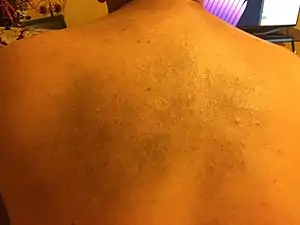Notalgia paresthetica
Notalgia paraesthetica (NP) or notalgia paresthetica (also known as "Hereditary localized pruritus", "Posterior pigmented pruritic patch", and "subscapular pruritus"[1]) is a chronic sensory neuropathy. Notalgia paraesthetica is a common localized itch, affecting mainly the area between the shoulder blades (especially the T2–T6 dermatomes) but occasionally with a more widespread distribution, involving the shoulders, back, and upper chest.[2]:402 The characteristic symptom is pruritus (itch or sensation that makes a person want to scratch) on the back, usually on the left hand side below the shoulder blade (mid to upper back). It is occasionally accompanied by pain, paresthesia (pins and needles), or hyperesthesia (unusual or pathologically increased sensitivity of the skin to sensory stimuli, such as pain, heat, cold, or touch), which results in a well circumscribed hyperpigmentation of a skin patch in the affected area.
| Notalgia paresthetica | |
|---|---|
| Other names | Notalgia paraesthetica |
 | |
| Notalgia Paresthetica | |
| Specialty | Neurology |
Causes
The correlation of notalgia paraesthetica localization with corresponding degenerative changes in the spine suggest that spinal nerve impingement may be a contributing cause. According to Plete and Massey, "The posterior rami of spinal nerves arising in T2 through T6 are unique in that they pursue a right-angle course through the multifidus spinae muscle, and this particular circumstance may predispose them to harm from otherwise innocuous insults of a varied nature." Patients may have other conditions that predispose them to peripheral neuropathies (nerve damage).
The causes of this condition have not yet been completely defined.[3] Patients are usually older persons.[4]
Treatment
Therapy for notalgia paresthetica is directed at controlling symptoms, as no cure exists for the condition. Available treatments include local anesthetics, topical capsaicin,[5][6] topical corticosteroids,[7] hydroxyzine, oxcarbazepine, palmitoylethanolamide and gabapentin. Paravertebral nerve block and botulinum toxin injections may also be helpful.
Some patients treated with low concentration topical capsaicin reported pain, burning, or tingling sensations with treatment, and symptoms returned within a month of ceasing treatment.[8] Oxcarbazepine was reported to reduce the severity of symptoms in a few cases.[9] One patient has been treated with "paravertebral nerve blocks, with bupivacaine and methylprednisolone acetate injected into the T3–T4 and T5–T6 intervertebral spaces" [10] Hydroxyzine has also been used with considerable success in some cases as long as the pills are used daily.
High concentration topical capsaicin (8%, Qutenza) have been shown to be highly effective in treating neuropathic itch in some patients[11][12] (including notalgia paresthetica) as well as in a recent proof-of-concept study,[13] but this remains to be confirmed in randomised controlled trials.
Most recently intradermal injections of botulinum toxin type A (Botox) have been tried with some success. Even though botulinum normally wears off in three to six months, the treatment appears to be long term, and it has been theorised that botulinum type A effects lasting change in pain signaling.[14] Unfortunately, repeated injections have been associated with diminished movement ability of the upper back and arms and its recommendation as a treatment has therefore become less popular.
See also
- List of cutaneous conditions
- Hereditary neuralgic amyotrophy
References
- Rapini, Ronald P.; Bolognia, Jean L.; Jorizzo, Joseph L. (2007). Dermatology: 2-Volume Set. St. Louis: Mosby. ISBN 978-1-4160-2999-1.
- Freedberg, et al. (2003). Fitzpatrick's Dermatology in General Medicine. (6th ed.). McGraw-Hill. ISBN 0-07-138076-0.
- Savk, E.; Savk, O.; Bolukbasi, O.; Culhaci, N.; Dikicioğlu, E.; Karaman, G.; Sendur, N. (2000-10-01). "ingentaconnect Notalgia paresthetica: a study on pathogenesis". International Journal of Dermatology. Ingentaconnect.com. 39 (10): 754–9. doi:10.1046/j.1365-4362.2000.00080.x. PMID 11095194. S2CID 24030363.
- "Skinsight - Notalgia Paraesthetica".
- Andersen, H. H.; Arendt-Nielsen, L.; Elberling, J. (July 2017). "Topical capsaicin 8% for the treatment of neuropathic itch conditions". Clinical and Experimental Dermatology. 42 (5): 596–598. doi:10.1111/ced.13114. ISSN 1365-2230. PMID 28556308. S2CID 3813025.
- Andersen, Hjalte H.; Sand, Carsten; Elberling, Jesper (February 2016). "Considerable Variability in the Efficacy of 8% Capsaicin Topical Patches in the Treatment of Chronic Pruritus in 3 Patients with Notalgia Paresthetica". Annals of Dermatology. 28 (1): 86–89. doi:10.5021/ad.2016.28.1.86. ISSN 1013-9087. PMC 4737841. PMID 26848223.
- Journal of the American Academy of Dermatology Volume: 32 Issue: 2 Pages: 287–289 Part: Part Published: FEB 1995 ISSN 0190-9622
- Weinfeld, Pamela Kirschner (2006-10-16). "JAMA Network | JAMA Dermatology | Successful Treatment of Notalgia Paresthetica With Botulinum Toxin Type A". Archives of Dermatology. Archderm.ama-assn.org. 143 (8): 980–982. doi:10.1001/archderm.143.8.980. PMID 17709655.
- JOURNAL OF THE AMERICAN ACADEMY OF DERMATOLOGY Volume: 45 Issue: 4 Pages: 630-632 Published: OCT 2001 ISSN 0190-9622
- JOURNAL OF THE AMERICAN ACADEMY OF DERMATOLOGY Volume: 38 Issue: 1 Pages: 114-116 Published: JAN 1998 ISSN 0190-9622
- Andersen, Hjalte H.; Sand, Carsten; Elberling, Jesper (February 2016). "Considerable Variability in the Efficacy of 8% Capsaicin Topical Patches in the Treatment of Chronic Pruritus in 3 Patients with Notalgia Paresthetica". Annals of Dermatology. 28 (1): 86–89. doi:10.5021/ad.2016.28.1.86. ISSN 1013-9087. PMC 4737841. PMID 26848223.
- Andersen, H. H.; Arendt-Nielsen, L.; Elberling, J. (July 2017). "Topical capsaicin 8% for the treatment of neuropathic itch conditions". Clinical and Experimental Dermatology. 42 (5): 596–598. doi:10.1111/ced.13114. ISSN 1365-2230. PMID 28556308. S2CID 3813025.
- Andersen, H. H.; Marker, J. B.; Hoeck, E. A.; Elberling, J.; Arendt-Nielsen, L. (2017-01-24). "Antipruritic effect of pretreatment with topical capsaicin 8% on histamine- and cowhage-evoked itch in healthy volunteers: a randomized, vehicle-controlled, proof-of-concept trial". The British Journal of Dermatology. 177 (1): 107–116. doi:10.1111/bjd.15335. ISSN 1365-2133. PMID 28117875. S2CID 13377266.
- NEUROTOXICOLOGY Volume: 26 Issue: 5 Special Issue: Sp. Iss. SI Pages: 785–793 Published: OCT 2005 ISSN 0161-813X
- Pleet, A Bernard and Massey, E Wayne, Notalgia Paresthetica, Neurology, Dec 1978; 28: 1310
- Pleet, A Bernard and Massey, E Wayne, Letter to the Editor: Notalgia Paresthetica, Neurology, Vol. 29, Issue 4, 528 April 1, 1979
External links
| Classification | |
|---|---|
| External resources |